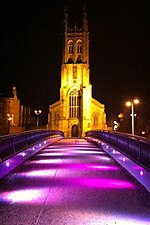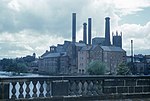Bath Street Mill
1851 establishments in EnglandBuildings and structures in DerbyEngvarB from September 2013Industrial buildings completed in 1851Silk mills ... and 1 more
Textile mills in Derbyshire

Bath Street Mill was a silk throwing mill in Derby, built in 1851 for George Holme. In spite of the recession in the silk industry in 1857, he expanded the mill in 1868. In 2008 plans were made to convert the mill into flats and offices, but the building was damaged beyond repair by a fire in June 2009, and later demolished.
Excerpt from the Wikipedia article Bath Street Mill (License: CC BY-SA 3.0, Authors, Images).Bath Street Mill
Bath Street, Derby Little Chester
Geographical coordinates (GPS) Address Nearby Places Show on map
Geographical coordinates (GPS)
| Latitude | Longitude |
|---|---|
| N 52.9297 ° | E -1.478 ° |
Address
Parklands View
Bath Street
DE1 3FG Derby, Little Chester
England, United Kingdom
Open on Google Maps








